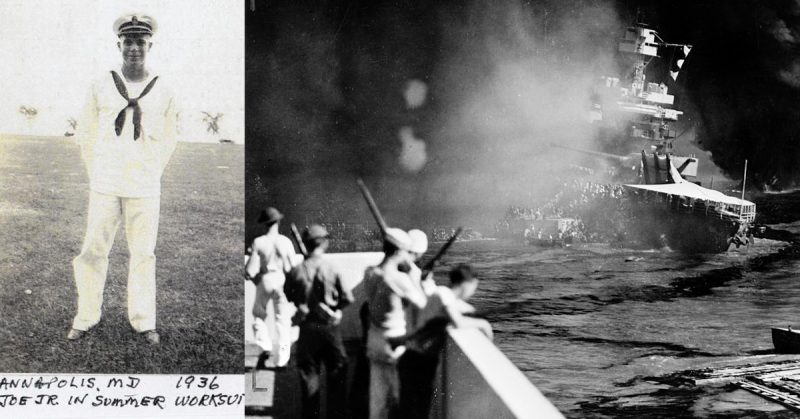The Defense Department announced last year that they are making another attempt to identify the remains of men killed aboard the USS Oklahoma when it was hit by torpedoes during the Japanese attack on Pearl Harbor on December 7, 1941. 429 sailors and Marines were killed on the Oklahoma in that attack. Many of those killed remain unidentified.
Ensign Joseph Parker Hittorff, Jr. was one of those casualties that has been finally identified. His remains arrived in Connecticut on June 18, 2016. His family is scheduling funeral and burial services.
Hittorff was from Westmont, New Jersey. He attended the Naval Academy because “he always wanted to go sea.” After graduation from the academy, Hittorff was assigned to the Oklahoma. He had completed the requirements to be promoted to lieutenant junior grade but was still waiting on his commission at the time of the attack.
Ensign Adolph Mortensen was also stationed on the Oklahoma. He survived the attack and wrote about it in the book, Pearl Harbor Survivors: An Oral History of 24 Servicemen.
After the torpedoes hit the ship, it began to list severely as water began quickly rising beneath decks. Because of all the loose items and furniture strewn about, it was difficult to walk through the ship. The hatches were not easy to open either because the ship was quickly rolling onto its side.
At the time of the attack, the Oklahoma was moored to the USS Maryland. To avoid being pulled under by the Oklahoma, the crew of the Maryland cut the mooring lines. This caused the Oklahoma to roll over 152° from vertical.
Hittorff told the ensigns that were assigned to him to abandon ship. Mortensen, Hittorff, and others went to the port side portals as the ship began to roll. “I soon found myself treading water and watching the ship as it rolled slowly above my head. I looked around quickly and could not see Hittorff and Goggins,” Mortensen wrote. “I assume that in time I averted my eyes and watched the ship they both slipped beneath the surface and drowned. I was told later that neither could swim.”
Hittorff’s academy ring was recovered and sent to his family along with a ceremonial sword. Posthumously, Hittorff was awarded the Purple Heart, the Victory Medal, the Asiatic-Pacific Campaign Medal and the American Defense Medal.
Herbert Rommel, Hittorff’s shipmate, wrote a letter to Hittorff’s sister. In it, he describes Hittorff’s final moments. While other crewmembers were abandoning ship, Hittorff went to the engineering room, trying to get the ship underway.
Rommel called Hittorff an “officer and a gentleman.” He praised Hittorff, saying, “After all, we all must die, and what could be better, but for a fighting man to go in action? What counts is not when we must go, but how we go, and how we have lived.”
The return of Hittorff’s remains has been in the works for a long time. Several years ago, his family was asked for a DNA sample to help identify his remains. They supplied a sample from his sister, Marion, who has since died.
Between 1942 and 1944, hundreds of service members were recovered from the wreckage at Pearl Harbor. Most of them were classified as “unknown” and interred in Hawaiian cemeteries. In 1947, those remains were dug up to be identified. 27 bodies were tagged to be identified, but approval for the work was never given. The remains were buried again at the National Memorial Cemetery of the Pacific.
In 2003, the Department of Defense dug up a casket with the remains of up to 100 sailors and Marines from the Oklahoma. In 2015, they announced that 388 more remains would be examined.
74 years after Pearl Harbor, the family was notified that Hittorff’s remains had been identified. On June 18, he finally came home.
